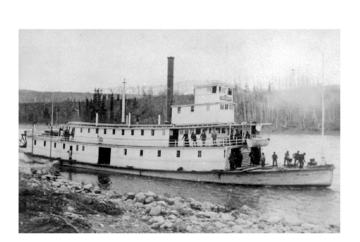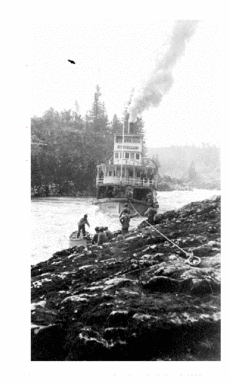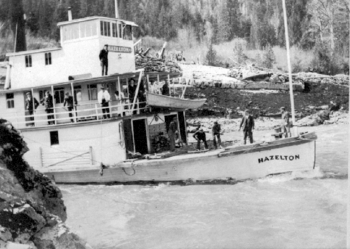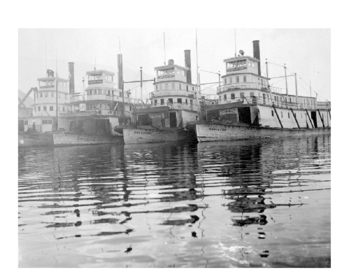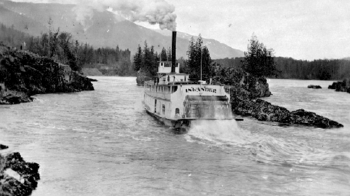Steamboats of the Skeena River facts for kids
The Skeena River in British Columbia is a very fast-flowing waterway. It can rise as much as 17 feet (5.2 meters) in a single day! The water level can change by up to sixty feet (18.3 meters) between high and low points. This made it one of the hardest rivers for steamboat captains to navigate in British Columbia. Still, at least sixteen paddlewheel steamboats traveled the Skeena River from the coast to Hazelton between 1864 and 1912.
Contents
Early Steamboats on the Skeena River
The first paddlewheel steamboat to arrive on the Skeena River was the Union. It was owned and operated by Captain Tom Coffin. In 1864, on its first trip from Victoria, it carried four passengers and 20 tons of goods. However, Captain Coffin soon realized he needed more preparation to go up the Skeena. That first trip was not successful.
In 1865, the Collins Overland Telegraph Company hired the Union. Captain Coffin decided to try the Skeena again. The Union struggled upstream for 90 miles (145 km) but could not go any further. The telegraph company then decided to build their own steamboat, the Mumford. It left Victoria with Captain Coffin in July 1866. This time, Coffin traveled 110 miles (177 km) upstream. He did this three times, successfully delivering 150 miles (241 km) of material for the telegraph line. He also brought 12,000 food portions for the workers.
Passengers on these early trips did not have a fancy or relaxing journey. They often had to help chop wood for the steamboat's hungry boiler! The Mumford left the Skeena in October and docked in New Westminster. Her adventures ended when the Collins Telegraph Company closed down. This happened because a telegraph cable was successfully laid across the Atlantic Ocean.
Hudson’s Bay Company and Robert Cunningham’s Boats
When the Omineca Gold Rush started in 1869, it became profitable to travel on the Skeena River again. Gold miners could easily reach the Omineca gold fields from Hazelton. A trail ran for 115 miles (185 km) from there, passing through Fort Babine and Takla Lake. At first, people used canoes to ship supplies from the coast. Captain William Moore worked for the Hudson’s Bay Company (HBC) to do this. Robert Cunningham traded on his own. This work was very hard, dangerous, slow, and expensive.
In 1889, the HBC decided to build a steamboat called the Caledonia. They hired Captain George Odin to be her pilot. She was launched on February 28, 1891, in New Westminster. Her first trip to Hazelton was that May, and it took nine days. The Caledonia was a success. She served not only the Skeena River but also the northern coastal areas. Captain John Bonser was hired as her captain. In 1895, the Caledonia was made longer and improved at his request. This made her easier to steer.
Captain Bonser named eleven of the canyons and rapids on the Skeena River. He used the way the obstacle looked or felt as a guide. Some names were the Whirly Gig Rapids, Hornet’s Nest Rapids, and the Devil’s Elbow Canyon. In Devil's Elbow, the Skeena River rushed directly towards a rock cliff before turning sharply right. Despite these dangers, the Caledonia operated for seven seasons. The HBC replaced her with a new steamboat in 1898, also named the Caledonia.
By this time, the Klondike Gold Rush was happening. There was more interest in the north than ever before. Robert Cunningham had become very successful. He now owned a fish cannery and a lumber mill. He decided a steamboat would be a great addition to his businesses. He bought the Monte Cristo and hired Captain Bonser away from the HBC to pilot it. The HBC built a second steamboat, the Strathcona. They were not too worried about Cunningham’s competing boat.
Then, in 1900, Cunningham sent Captain Bonser to Victoria to design a new steamboat. This boat became the Hazelton. Under Captain Bonser’s command, she quickly proved to be better than the other boats on the Skeena. In her first season, she went to Hazelton thirteen times. The trip upstream took forty hours, and downstream took only ten. The HBC realized that their Strathcona and Caledonia could not compete. So, they built a third steamboat, the Mount Royal, and hired Captain Johnson as her pilot. On her launch day, April 9, 1902, she got stuck. After two hours, she was freed, only to get stuck again. A bad launch was seen as a bad sign, and for the Mount Royal, this turned out to be true.
Steamboat Race on the Skeena River
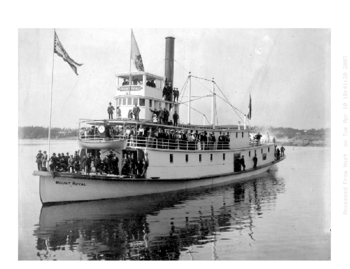
When the HBC's Mount Royal arrived on the Skeena, a rivalry quickly started between her and Robert Cunningham’s Hazelton. Each captain tried to beat the other's travel times to Hazelton and back. The order from both companies was simple: "beat the other boat." This naturally led to a side-by-side race, an old but risky tradition among steamboats.
In the spring of 1904, both boats wanted to be the first of the season to reach Hazelton. Captain Bonser started out first in the Hazelton. While he was stopping to load wood for fuel 105 miles (169 km) upstream, he saw the Mount Royal, with Captain Johnson steering, coming up from behind. Loading wood stopped immediately. The Hazelton pulled into the river as the Mount Royal got closer, and they raced side-by-side.
Slowly, the Mount Royal started to pull ahead of the Hazelton. Captain Bonser was not going to let that happen. He bumped the Mount Royal several times. Captain Johnson lost control, and the current carried the Mount Royal back downstream, front-first. Captain Bonser wiggled the Hazelton’s back end at the Mount Royal, blew the whistle, and continued triumphantly upstream. Furious, Captain Johnson left the steering area to get a rifle and shot at the departing Hazelton.
Afterwards, Captain Johnson accused Captain Bonser of deliberately ramming the Mount Royal. Captain Bonser said it was an accident. The government investigated and decided that both captains were at fault. Bonser for ramming, and Johnson for leaving the steering wheel. The men were warned, and the case was closed.
The HBC and Robert Cunningham decided that the rivalry was not good for business. They made an agreement to end it. The HBC paid Robert Cunningham $2,500 to stop using his boat, and they carried his goods for free. Later, the HBC bought the Hazelton. These new arrangements left Captain Bonser without a boat until 1906. He then took command of the Pheasant, a small steamboat that was often joked about and nicknamed the "Chicken." This was because it had to work so hard to go upstream. She was wrecked that autumn in the Redrock Canyon. This was the first time Captain Bonser lost a boat in his long career, but not the last. Captain Bonser’s next boat was the Northwest. It was owned by the Northern British Columbia Transportation Company. This company also had a hotel and store in Telkwa. The Northwest's main job was to deliver supplies from the coast to hotels along the Skeena.
The Sad Story of the HBC Mount Royal
In 1907, Captain Johnson was still in charge of the Mount Royal. On the afternoon of July 6, he was returning from Hazelton and steaming through the Kitselas Canyon. Suddenly, a strong wind pushed her into a large rock formation called Ringbolt Island. She got stuck sideways against the strong current. The boat held while the passengers and crew quickly climbed to safety on the shore.
Captain Johnson looked at the situation and thought the Mount Royal could be saved. With ten crewmen, he went back on board. He decided the best way to fix the problem was to use the capstan (a type of winch) to pull the steamboat back over Ringbolt Island. This turned out to be a very bad decision. The main support pole broke and went through the bottom of the Mount Royal. The boat bent as the current washed over her. Then, she rolled upside down and broke into pieces.
Captain Johnson survived, but six of the crewmen drowned, including the first officer. One of the four survivors was rescued by George Little. George later became the founder of the town of Terrace. George and a friend saw the wrecked hull floating past the community of Kitselas. Curious, they paddled out to it. They saw a hand waving at them from a hole in the hull. The survivor was the Mount Royal's chief engineer, Ben Maddigan. He was trapped inside, dirty but not hurt. After George chopped him out, he commented that there must have been some air down there. The tired engineer replied, "I don’t know about air, but there was one hell of a lot of water!"
Captain Johnson went on to pilot the new steamboat built to replace the Mount Royal, which was the HBC's Port Simpson.
Two months after the Mount Royal was wrecked, another steamboat was lost on the Skeena. The Northwest, which was Captain Bonser’s second loss, hit a rock and sank. No one died, but she was carrying the winter supplies for the towns along the Skeena. Her loss still caused a bit of a stir. To help with this small problem, the HBC quickly fixed up the Caledonia. She made an emergency trip up the Skeena with the much-needed supplies. Captain Bonser then moved to the upper Fraser River in 1909. There, he piloted two steamboats before returning to the Skeena in 1911.
Grand Trunk Pacific’s Steamboats
The Grand Trunk Pacific Railway’s western end was in Prince Rupert. Railway construction began there in 1908. The railway construction company, Foley, Welch and Stewart, built the Distributor and the Skeena. They also bought the Omineca in 1908. The Omineca was wrecked later that summer near Port Essington. However, her machinery was put into another steamboat, and she was renamed Omineca in 1909. That same year, Foley, Welch and Stewart launched two more steamboats: the Operator and the Conveyor. These would be piloted by Captain Con Myers and Captain Jack Shannon.
These five steamboats had a lot of work to do. Building the railway from Prince Rupert to Hazelton was one of the most difficult sections of track ever laid in North America. This 186-mile (299 km) stretch took nearly four years to build and employed thousands of workers. Four of the company's steamboats hauled materials and supplies for construction. A fifth, the Skeena, was used almost only to bring food to the construction workers' camps. Much of these supplies came from meatpacker Pat Burns. He had wisely guessed this need and built a slaughterhouse in Hazelton.
The Last Steamboat
In 1910, the last steamboat built for work on the Skeena River was the Inlander. It was owned by local residents and business people. Captain Joseph Bucey piloted her for that navigation season. In 1911, Bucey left for the upper Fraser River. He worked on the steamboat BC Express until 1921. Captain John Bonser, now back from the upper Fraser, replaced Bucey on the Inlander. He piloted her for the 1911 and 1912 seasons.
Then, in August 1912, the railway line was finished to Hazelton. This was the end for the Inlander. She left Hazelton for the very last time on September 13, 1912, with Captain Bonser. When she reached Port Essington, the Inlander was pulled onto land and left to rot. Like the Inlander, Captain Bonser had also made his last trip. He passed away on December 26, 1913.
End of an Era for Steamboats
After 1912, the Skeena River was no longer used by steamboats for river travel. The GTP boats, Operator and Conveyor, were taken apart. Their machinery was used in new steamboats built at Tête Jaune Cache for railway construction further east. Their pilots, Captain Myers and Captain Shannon, stayed with them until 1914 when the railway line was finished.
The Distributor and the HBC Port Simpson were also taken apart and rebuilt. They later worked together on the Mackenzie River. The HBC's Hazelton became the clubhouse for the Prince Rupert Yacht Club.
The Skeena was bought by Captain Seymour in 1914. She went on to work on the lower Fraser River. For eleven more years, her captain-owner's dedication kept her traveling the river past Surrey, Coquitlam, Maple Ridge, Langley, and Mission. But when Captain Seymour died in 1925, she lost her only supporter. She was sold and turned into a floating barge for an oil company. This was the end for the last of the Skeena River steamboats.



